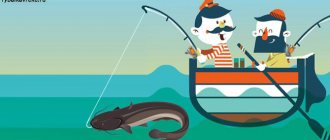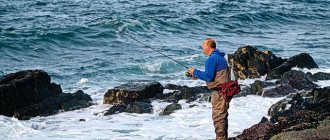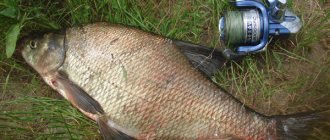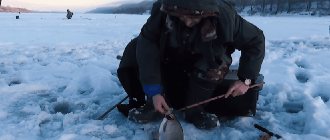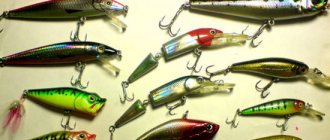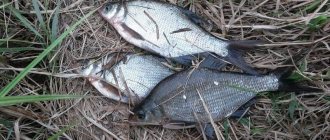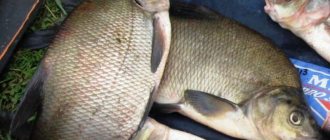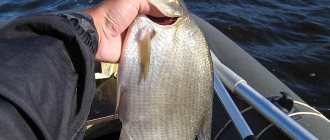A bream descender is a rather specific, but very effective tackle for winter fishing. Structurally, harvesters, also known as harvesters, are a variation on the theme of winter donks. Moreover, this tackle itself is by no means new - it has been used for decades. And it shows decent results. However, its use requires special skills, the ability to properly prepare the tackle, operate it competently, and choose places suitable for catching bream using a combine harvester. Such demands on skills and abilities can explain its rare use by fishermen. However, there is nothing too specific in using the descender; you can understand all the intricacies. And Trophy experts are ready to help you with this.
GUARD V-KSH No. 2 TWISTED OVAL 6-8GR Three whales 19 for 1 piece. GUARD V-KSH No. 1 TWISTED DROPS 4-6 GR Three pillars 19 for 1 piece. GUARD V-KSH No. 4 TWISTED DROPS 8-10 GR Three whales 24 for 1 piece. Nod type-6 Turn Tonar 28 for 1 piece. Gatehouse B-2 twisted, red 3-4g. Three whales 12 for 1 pack. GUARD twisted B [email protected] (assorted colors) (pack 25pcs) (2-3g) Three whales 12 for 1 pc. Gatehouse Twisted internal. Pierce Pierce 19 for 1 piece. Nod type-2 Coil Tonar 19 for 1 pc.
All winter nods in the catalog
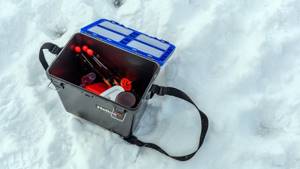
Features of the selection of components
The feeder is excellent for successfully catching bream, because with its help you can catch prey both in the current and in calm places. When choosing equipment, an important attribute is a high-quality fishing rod. On rivers, the most optimal rod length is 4–4.5 m, since you need to make long casts with a heavy feeder.
When fishing takes place in a body of standing water, a fishing rod no more than 3 m long is used, consisting of several parts and replaceable tips of varying hardness.
Equipment for bream consists of the following basic elements:
- fishing lines;
- connection means;
- hooks;
- feeders;
- anti-twist;
- stop beads.
Many anglers equip their fishing rod with special bite alarms through which the main line passes. But it is usually customary to navigate by the top of the rod, which begins to bend when the fish jerks.
Fishing lines
The main and rigging lines can be identical - for example, a braided cord selected specifically for catching cautious fish.
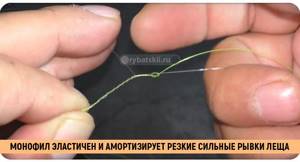
It should be remembered that when sharply hooked and fished, the bream will strongly resist, and this will create an additional load on the equipment. Therefore, the assembly of leashes and paternosters must be carried out only from monofilament with a diameter of 0.2 mm.
Connection means
Beginner fishermen do not use connection devices, believing that they make the equipment more noticeable. Indeed, the cautious bream is very suspicious of various unmasking components, so instead of carbines you should use inconspicuous swivels.
For braided cord, devices with a round cross-section are excellent.
The main rule is simplicity of design, because the more complex it is, the faster it will break during active fishing. When using monofilament, all known types of joining agents can be used.
Hooks
Some feeder gear for cautious bream involves self-hatching. For this reason, sharp and strong hooks are needed that will catch on the soft tissue of the prey even with a slight tug. When fishing, the sting goes much further and securely fixes the trophy on the hook. To catch large fish, you should use products with numbers 14–16. When fishing for smaller fish, you can use jigs numbered 8–10, but you need to use large bait on them.

Feeders
When buying a feeder for a feeder on a current, you should opt for open-type devices. A round cormak is of little use in strong currents. The optimal weight of the device is considered to be 120 g. With such a mass, the product does not have time to move much when lowered to the bottom.
Oval feeders should be used on lakes with standing water, as well as with a small current. They are very different from their counterparts in that they have large cells that allow the bait to quickly spread in the water.
Anti-twist
Many equipment schemes often contain slightly bent tubes, which are called anti-twist tubes. These devices are designed to completely eliminate overlaps. According to many fishermen, it is necessary to choose this device based on the color and vegetation of the bottom, so as not to scare off the intended prey.

Stop beads
In specialized stores you can find stop beads in bright colors, but they are more suitable for predatory fish. For bream, it is worth buying stoppers that have the opposite qualities, since this is an extremely cautious fish, the equipment for which must be carefully camouflaged.
Feeder equipment for current
If bream fishing takes place in a reservoir with a current, then you should give preference to a medium or heavy rod, the recommended test is 110g. Both braided and monofilament fishing line with a cross-section of 0.2 millimeters are suitable as fishing line. A fluorocarbon leader with a cross-section of 0.2 millimeters will work well.
When choosing a hook, it is necessary to take into account the size of the planned catch. The open type feeder is within 120 grams, but adjustments are needed depending on the specific conditions of the reservoir. A helicopter and two knots, as well as an asymmetrical loop, are suitable as equipment, and the bait is chosen based on the time of year.
In summer you need plant bait, and in spring and autumn there should be mainly animal baits in the form of maggots or worms. Complementary foods are selected according to the same parameters. Important! The complementary food must contain the same ingredient as the bait.
Determining the fishing distance
Initially, you need to study the bottom. Holes, irregularities and depressions are priority for casting. The bottom can be studied using both an echo sounder and a marker rod. Oscillations and impacts when pulling the load indicate stones and other obstacles in a specific area of the reservoir.
The best bottom for feeder fishing is clay. As a rule, it is located on the border of stones and a flat bottom. You can understand that the feeder is in clay by lifting the tackle. If the feeder does not get stuck, you are most likely on clay soil.
In order not to lose the chosen place, it is worth counting the number of revolutions of the reel when casting, or using a rubber band as a stopper. The elastic band is placed on the spool and will prevent the excess line from unwinding during the next casts.
It is also worth identifying several noticeable objects in the environment for yourself in order to make the most accurate throws possible. The depth can also be calculated by the revolutions of the coil.
Selection of equipment
Catching bream on a feeder is the most effective. This method can catch prey in a variety of conditions. Most often, fish live in bottom holes near snags. If you feed the chosen place well, you can count on a decent catch.
Bream constantly gather in schools, so you should try to keep them near the feeders.
When fishing for cautious bream, you must have the following additional equipment:
- fishing lines for making broken leashes;
- spare feeders;
- round nose pliers for removing the hook from the prey;
- a stand for placing a fishing rod;
- cage
Feeder fishing requires certain skills. When choosing a method for installing gear, you should take into account the type of water you will be fishing on. Also, the equipment depends on the natural conditions of the reservoir.
Feeder rig for bream in the current
For fast flows, feeder equipment is used using heavy feeders and a strong main line. The complementary food should be dense and viscous so that under the influence of water it is gradually washed out, and the feed is retained in a certain place where bream accumulate.
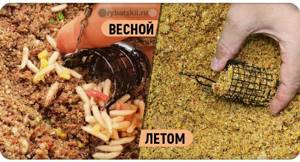
In summer, you need to use complementary foods of plant origin, and when catching bream in the spring, use animal baits on the feeder. When fishing in strong currents, you should constantly check the reel clutch. When it is in working condition, when fishing for large prey, there will be no breakage of the line or leash with the hook.
Rigging in still water
Lake fish are very careful and shy, so the rod needs to be equipped completely differently. The absence of a strong current allows the use of light baits, thin leashes and small hooks.
In reservoirs, bream are not very shy, and the water in them is often not so clean. But in these reservoirs you need to make long casts, because most of the holes on the bottom are located at a considerable distance from the shore.
The equipment for still water is very similar to the river one, only it uses lighter feeds and shorter leashes.
In currents, bends of a meter or more are often used, but on lakes a length of 30–50 cm is sufficient. If the bite is bad, you should drag the bait along the entire length of the leash in order to move the bait from its original place and place it in the bait spot.
Feeder equipment for catching bream depending on the season
The feeder installation for large bream in the summer should be extremely reliable and a little rough, since during these months it actively grabs the bait and is practically not afraid of the bait, because there is a large amount of debris, plant debris and various floating particles in the water.

In summer, fish bite well on plant baits - corn grains, boiled peas and pearl barley. The main emphasis should be on high-quality fishing techniques and high-quality complementary foods.
In cold weather, it is worth using thin long leashes and small hooks, and it is not recommended to add a lot of feed additives to the porridge, as you can oversaturate the prey.
In the spring before spawning, the bream begins to eat, and in late autumn you can successfully catch the pre-winter bite. In autumn, the fish do not feed as actively, so it is quite difficult to catch them. Because of the clear water, the equipment should be made extremely thin and neat, and there are certain nuances in the technique of working with complementary foods and baits.
Float rod
Let's start the story with the simplest gear: a float rod. Depending on the bream fishing conditions, the following can be used:
- fly float - when fishing from the shore on a small river or from a boat in shallow places
- lap dog - for fishing with retrieval at short distances, up to 20 meters
- match – for long-distance fishing
- plug – in places with a clean bank for point feeding of bait
The best time for float fishing is spring and early summer. It is at this time that schools of bream rise closer to the shores, where they can be caught with the specified gear. At the same time, do not forget about bait, which can keep the fish at the selected fishing point.
The following elements are placed on the match and lapdog:
- main line 0.22-0.25 mm thick
- the float needs a carrying capacity: from 2 to 15 grams depending on fishing conditions
- appropriate load of several pellets
- leash 0.12-0.14 millimeters
- hook depending on the size of the bait
The plug and fly fishing rods are equipped a little more delicately. Thus, a monofilament base usually does not exceed 0.14 millimeters in diameter, and a leash - 0.12.
Line or cord depending on fishing conditions
Each tackle for catching large bream on a feeder has not only its advantages, but also disadvantages. Braid allows you to react faster to bites because it practically does not stretch. But when using it, the risk of prey disappearing during fishing increases. In this case, the optimal solution is to use feeder rubber, which absorbs sudden jerks. The optimal cross-section of a braided cord is 0.17 mm.
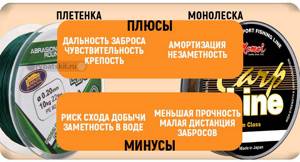
When choosing a monofilament, you should choose a diameter of 0.2 mm, since the fishing line has less strength compared to the cord. The short casting range is compensated by good shock absorption when fishing for bream for a long time. And also the main advantage of monofilament is its invisibility.
Baits and baits and their combinations
Choosing the right bait depends on the time of year. During cold periods, fish accept animal baits well, so worms and bloodworms are optimal for autumn fishing. In summer, bream mainly feeds on plant foods. For this reason, to catch it on the current, it is worth using corn grains, boiled peas and other grains or legumes.
You can also use different larvae or combine them in the form of a sandwich with herbal ingredients. Don't forget artificial baits. Bream bite well on foam balls.
The following options can be used as a plant attachment:
- steamed peas;
- canned or fermented corn;
- boiled or fermented pearl barley.
When there is a bad bite, you should use the following combinations of attachments:
- peas and bloodworms;
- pearl barley and worm;
- corn and maggot.
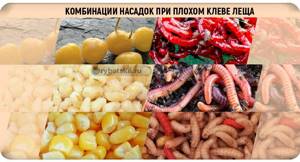
In conditions of poor bream biting, a sandwich made from a garlic boilie, an earthworm and several maggots gives a good result. It should be remembered that this fish is caught mainly in the evening or at night, when it is looking for food in the shallows and near the shore.
Bait for bream is the basis for success
The modern angler uses ready-made commercial bait to attract fish. There are many dry feed formulations available that can be quickly prepared right on the shore. Unfortunately, their consumption in bream fishing is usually high. And such food goes out instantly. If there is an abundance of small fish in the fishing area, it will simply not allow the bream to approach the bait, destroying it before the bream school approaches. Therefore, it is necessary to add a large component to the bait, as well as soil for starting feeding. This can be pellets, cereals that are added to food, compound feeds, which in their essence differ little from pellets and successfully replace them.

The soil for catching bream is added in a dark color, since it prefers to stay on those areas of the bottom that are darker in color. Garden peat is excellent. It is quite light and loose, and even after moistening it is easy to find particles of bait in it. Another important quality is that it is quite porous and when immersed in water it begins to release oxygen. This attracts fish, as the bubbles make certain sounds underwater. For the same purpose, bait is usually sifted through a sieve - air particles get stuck between the particles of bait, and it releases bubbles at the bottom.
The animal component is also important for bream. It is added to bait in the form of bloodworms, maggots or worms. When fishing with a feeder, using a large feeder allows you to deliver live food to the bream. This is important so that the bloodworms move at the bottom, the maggots dig into the bait soil, and the worms crawl along the bottom. All this provides a sound accompaniment that the bream perceives as a signal to eat. He will willingly eat both worms from bait and a hook with a nozzle, becoming a fishing trophy.
How to choose bait for bream
Spring bait
To fish in reservoirs with a current, it is necessary to add viscosity ; for this, clay from the reservoir and pea flour are used. Fraction : small, but always with the addition of large pieces of live maggots and food bloodworms. Color : light Smell : coriander is the best option Additives to attract large fish: instant corn, crushed peas, scalded maggot
Summer baits
In the summer heat, many complain about a complete lack of bite , but this is not always true. Properly selected bait can attract the attention of bream even in the heat. June: worm, maggot, corn, peas, pasta. July: steamed barley, maggot worms in the form of sandwiches. August: bread, pasta, corn, maggot worm. Temporary decreases in temperature indicators will entail a return of bream to animal types of bait ; vegetable bait should be offered in hot weather.
Autumn lures
In the autumn, bream continue to be actively caught on the feeder; groundbait and bait, as before, should work in tandem in such gear. As the temperature drops, bream will again want “meat” baits. September: earthworm and dung worm, maggot, hominy, bread, steamed cereals. October: bloodworms, worms, less often maggots. November: maggots and bloodworms, plant-based baits will not work. It is important to understand that the bait used in crushed form must be added to the bait.
Winter lures
In winter, bait for bream is very important; it is more difficult for passive fish to attract attention . Therefore, the selection of bait should be approached very carefully. December: sandwiches made from pieces of worms, bloodworms and maggots, less often boiled peas are used. January: bloodworm, worm. February: worm, bloodworm, semolina, peas. You can experiment and try using the dough as bait; at the end of February, bream can respond well to this species.
When fishing with a float rod, it is very important to remain quiet. But what if the bait on the bottom is destroyed by the fish after half an hour of fishing? Will the fish leave and not return, or will you have to feed the point again, scaring away the one that remains? Not at all. The bait balls should be prepared in different consistencies. Some should disintegrate at the bottom immediately and be more loose. Others retain their shape for a long time and only fall apart after some time. The soil significantly extends the life of the bait. It not only creates a nutrient spot on the bottom for the fish, but also makes it difficult for the fish to eat food, forcing it to rummage in the bottom. The latter sometimes helps get rid of roach bites. She doesn’t really like to dig into the mud, but bream, on the contrary, prefers what lies below.
Types of installations and their purpose
To catch bream, you should choose the right feeder equipment and method of its installation. The most popular methods are the Gardner loop, symmetrical loop, paternoster, asymmetrical loop and helicopter rig.
Gardner's loop
Due to its ease of installation and good catchability, the Gardner loop is considered the most favorite equipment of many novice fishermen. Its only drawback is the twisting of the main line, which appears after a couple of casts. To solve this problem, you need to slightly lift the feeder and spin it.
Monofilament is more susceptible to twisting; with braided cord this happens much less often.
To use this installation method, you need to make a loop at the end of the main fishing line to which a leash with a hook will be attached. When tightening, the knot should be slightly moistened to maintain its structure.

Then another loop is made 20 cm higher, into which a feeder up to 15 cm in size should freely pass. The leash is attached to the main fishing line, threaded into the end loop and wrapped around it.
Symmetrical loop
A symmetrical loop is quite simple to make, but its effectiveness is not inferior to a paternoster. It rarely tangles and is often used in still water. To make it, you need to fold the monofilament in half, and then twist it by rotating it. After 10 cm from the twist, a knot is made to which the swivel is attached.
At a distance of 15 cm from the swivel, another knot is made and twisting is performed again. A leash made of fishing line up to 80 cm long is attached to the end of the swivel, to which the hook is tied. Then, using the “loop-to-loop” method, the feeder is attached to the swivel on the feeder.
Paternoster
After casting, the line tightens and the rod tip bends slightly. When the feeder lies on the bottom, the paternoster is also in tension, and the hook on the leash lies on the bottom. After the fish takes the bait, it begins to swim deeper and the device immediately weakens. Thus, the bream does not feel the feeder and swallows the bait deeper. Using a paternoster, the tip of the rod will quickly indicate a bite.
Loop asymmetrical
The main difference between an asymmetrical loop is its shoulder. This method is effective when fishing in still water, when calm and stable bites occur.
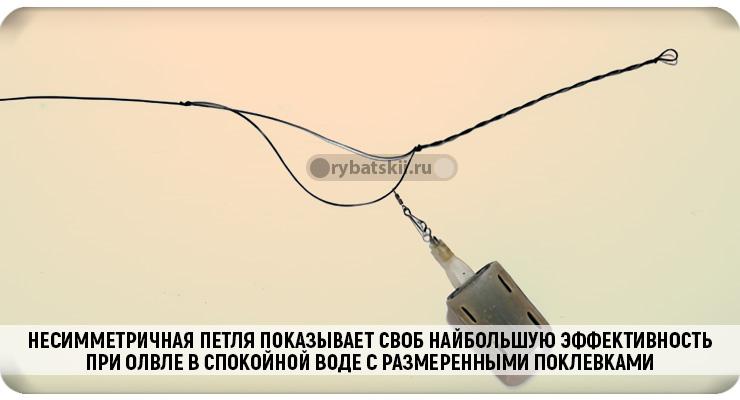
To make it, you need to fold a piece of monofila about 50 cm long in half. One end of it is attached to the main fishing line using a knot, so that you end up with a circle on which a loop is made and the feeder is secured. Installation of a leash with a hook is carried out on the loop made.
Helicopter
When the bream bites are aggressive and the current on the river is quite fast, then it is better to assemble a helicopter for fishing that can self-hook prey. To make it, you should take a rigid monofilament with a thickness of 0.35 mm. Many fishermen use fluorocarbon for these purposes.
Then you need to fold 25 cm of fishing line in half and twist a knot at a distance of 15 cm from the end. Then the monofilament is folded into a figure eight and a second knot is made 1 cm from the edge. The feeder is secured using the “loop-to-loop” method, and the leash is threaded between two knots and securely attached.
Installation of tackle for bream with your own hands
Start your assembly by purchasing the right fishing rod. Remember that no fishing rod is designed to catch everything, although all-purpose rods will perform the maximum number of tasks. A short rod will be the right choice if you are casting hooks close to the shore or where the fish winter near the pool. To cast into the distance, you need a model over 4 m long. Then a reel with fishing line is fixed to the rod. And at the end they begin to collect gear. For bottom fishing, you don't need a float unless you decide to use one instead of signaling the angler to start a bite. Then it needs to be placed at the top of the structure.
Installation and installation of gear occurs as follows:
- A sinker is placed at the very bottom end of the line.
- There is a fishing line attached to it on an elastic band or leash.
- A feeder and hooks with leashes are placed on it. Between them there should be stoppers made of beads, which will prevent the tackle from getting tangled and the hooks from moving.
- A sinker is thrown into the pond, which pulls the rest of the equipment along with it.
- When the load falls to the bottom, the excess line is wound back into the reel.
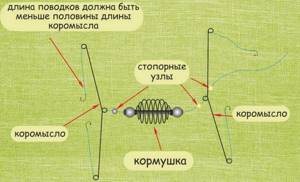
Lure for bream
The choice of bait is an important part of successful feeder fishing for bream, because the predator can smell it from a great distance. In addition to the pleasant aroma, the color of the porridge is also important. The fish also has acute hearing, so making noise while fishing is strictly prohibited. At the first sign of danger, she immediately swims away.
The bait is prepared based on the characteristics of the bottom of the reservoir. With a strong current, you need a coarse and dense porridge. In still water, you should reduce the density of the bait so that it erodes at an optimal speed.
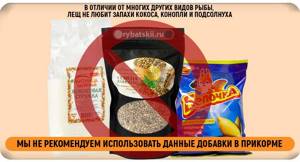
It is not recommended to use the following components in complementary feeding:
- coconut flakes;
- hemp;
- sunflower seeds.
The bait should be soaked for 12 hours before fishing and placed in a dark place so that all the components mix and swell. Coastal soil as an ingredient will help even out the flavor of the porridge for wary fish.
It is necessary to take into account that complementary foods must contain the same components that are used as bait. Animal ingredients, such as maggots, should be doused with boiling water beforehand to prevent them from being washed away by the current. The vegetable component of the porridge can be pearl barley or corn.
Bottom fishing rod

Fish feeding is especially relevant in summer and autumn. Donka is used in quiet reservoirs.
Design features of bottom gear:
- Telescopic type of fishing rod with a length of 1.5 - 2 m.
- Inertia-free reel model with a size of 2000 - 3000.
- The main line is the same as for the previous tackle.
- A load with a weight of 15 - 50 g.
- Several leashes equipped with hooks numbered 6 – 14.
- You can use a bell or an electronic model as a bite alarm
Based on numerous observations, it is effective to equip bottom tackle with a feeder (a spring for fishing in still water and a feeder feeder with a load for fishing in strong currents). The presence of a feeder makes it possible to target feeding with each subsequent cast.
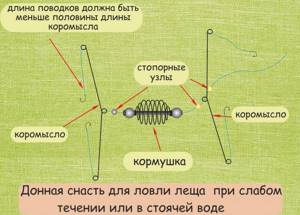
Types of bottom tackle:
- Rubber. The advantage of this design is that it simplifies the fishing process itself; there is no need to frequently throw and pull out the tackle. It is better to use elastic bands in small water areas with moderate currents.
- Makushatnik. The tackle consists of a feeder made of a lead plate, to which pieces of sunflower cake are attached, and sharp hooks are hidden in the top of the head.
- Pacifier. Here the feeder is also made of lead material, but a lid from a plastic canister or glass jar is mounted on it, into which the finished bait with hooks is placed.
- Ring. This type of donkey is made by hand from a steel ring weighing 20–50 grams and having a narrow cut. The cut, in turn, is necessary for threading the fishing thread of the feeder and for opening the main fishing line. The feeder is made of mesh, perforated plastic, its loading should be 1 - 3 kg.
- Eggs. The tackle is similar in principle and tactics to the ring, but unlike it, it consists of a large safety pin equipped with lead balls at the ends. The main line is threaded through a special hole, and the feeder line is passed between the balls. Eggs are a universal tackle; it works at any time of the year, but in open water.
How to choose a fishing point
The choice of a specific place on a reservoir directly depends on the season, since at different temperatures the location of the bream changes, and its behavior also changes due to weather conditions. In cool times, it often basks in shallow water, and waits out the heat in depth. Knowing the habits of a fish, you can catch it even for a whole day.
The bream is quite active in taking bait at depth. If the bottom is strewn with shell rock, then this is an ideal place, because its main food is there.
In the selected area, you need to make primary bait. The sweet spot should be small so that the school of fish does not scatter, but remains in a certain place. After this, you can start catching it.
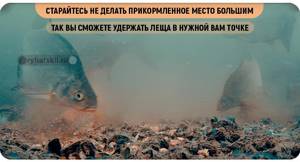
Habits
Bream is a fairly large fish, although it is far from a record holder in terms of weight. The largest fish reach a weight of six kilograms. Most often, individuals from half a kilo to a kilogram are pecked on the hook; this fish is usually called a bream. Bream weighing three kilograms is in most cases a trophy catch.
The body shape of the bream is laterally flattened and elongated in length. This helps him avoid the teeth of the pike, which simply cannot open its mouth enough to grab a wide fish. It grows very quickly, and as a result, having reached large sizes, it has practically no natural enemies in the reservoir.
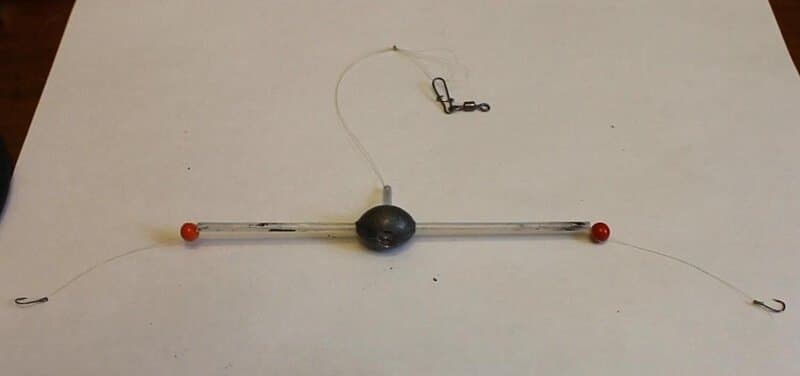
The peculiarity of its nutrition is associated with its body shape. When searching for food, bream is guided by the organs of vision, hearing, lateral line and especially smell. This fish is very sensitive to odors, which is worth taking advantage of by adding aromatics to the bait. But you shouldn’t overdo it, since a bream’s good sense of smell will immediately distinguish between a dirty trick and an unusual smell, and you will lose all bites altogether. After the bream finds food at the bottom, it takes a vertical position in the water and draws it into itself with its mouth, working with its gills. After this, the bream straightens up and moves to the side.
A bite on a float rod allows you to see this feature. When biting bream, the float never dives sharply down. Even if he bites at half-water when fishing for roach, he always lifts the float and drags it to the side. A large bream, capable of completely tearing the sinker off the bottom, can even lay the float on its side. Many other fish with a wide body shape behave in the same way - carp, crucian carp, silver carp.
Tips for choosing bait for bream
Spring baits
Depending on weather conditions in the spring, bream can actively react to different baits: March: bloodworm, worm, semolina, dough. April worm, maggot, bloodworm. May peas, corn, dough, pasta, semolina, bread, boiled wheat, pearl barley. The higher the air and water temperatures, the faster the bream switches from animal baits to plant baits.
Summer baits
In the summer heat, many complain about a complete lack of bite, but this is not always true. Properly selected bait can attract the attention of bream even in the heat. June: worm, maggot, corn, peas, pasta. July: steamed barley, maggot worms in the form of sandwiches. August: bread, pasta, corn, maggot worm. Temporary decreases in temperature indicators will entail a return of bream to animal types of bait ; vegetable bait should be offered in hot weather.
Autumn lures
In the autumn, bream continue to be actively caught on the feeder; groundbait and bait, as before, should work in tandem in such gear. As the temperature drops, bream will again want “meat” baits. September: earthworm and dung worm, maggot, hominy, bread, steamed cereals. October: bloodworms, worms, less often maggots. November: maggots and bloodworms, plant-based baits will not work. It is important to understand that the bait used in crushed form must be added to the bait .
Winter lures
In winter, bait for bream is very important; it is more difficult for passive fish to attract attention. Therefore, the selection of bait should be approached very carefully. December : sandwiches made from pieces of worms, bloodworms and maggots, less often boiled peas are used. January : bloodworm, worm. February : worm, bloodworm, semolina, peas. You can experiment and try using the dough as bait; at the end of February, bream can respond well to this species.
This type of fishing completely excludes the bite of large bream in shallow water. It simply will not be able to take the required position for eating, since it will not have enough depth, and therefore in such places you can only find a small underbreeder. In addition, you should use long leashes when fishing. The bream, when it lifts the bait and feels the weight of the sinker, will simply spit it out, and you will lose your catch. The leash must correspond to the size of the fish being caught and the hook must be at a great distance from the sinker - both in bottom fishing and in float fishing. However, you shouldn’t make it too long, as this will lose the sensitivity of the tackle, and in feeder fishing the leash will lie too far from the feeder.
Bream wintering usually takes place in very deep places, from five meters or more. In such depths there is eternal twilight, odors do not spread well in cold water. The fish's metabolism is slow due to the low water temperature. However, sometimes bream comes out to feed. It can be caught with winter fishing rods and jigs. At very great depths, from 15 meters or more, in winter, bream can be caught even in mid-water. Mostly small bream are actively biting. The bites of serious bream at this time are cautious or absent altogether. Sometimes getting warm water under the ice helps correct the situation. Then the bream becomes more active and begins to feed a little more actively.
Influence of weather and time of day
Bream fishing should be done in slightly windy weather. Since he is very cautious, he rarely rises from his hiding place during quiet and calm periods. At this time, the fish is at the bottom or in vegetation, snags. When fishing, it is necessary to take into account weather conditions, otherwise you may be left without a catch.
Bream is very sensitive to temperature changes. On hot days it is at great depth and almost does not react to bait. During the summer months, it is worth going fishing at night or early in the morning. Night fishing for bream with a feeder is done in shallow water, where the fish emerge from the holes to search for food. At this time she is the most active and carefree.
Where and when to catch bream on the current in winter?
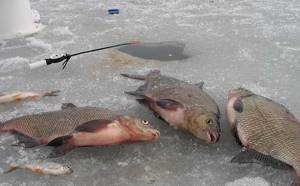
- Bream likes to be in large holes and depressions, where it finds food. Bream also often swims in the current, waiting for the water to bring it food. Therefore, in order to catch it, you need to notice the habitats of this fish since the summer;
- then remember a tree or a dry trunk on the shore; another option is to leave landmarks on the shore in the summer. If fishing is carried out on an unfamiliar river, you need to ask local fishermen where it is better to catch bream;
- in order for the fishing to be successful, you can make several holes for bait and fishing, try everything and find out in which the fish will bite;
- when the thaw comes, the fish will be in the depths or near the river beds. At the very beginning of winter, the fish is 2 or 3 m from the bottom, in the middle of winter at a depth of 5 m;
- The weather also has a great influence on fishing; at low atmospheric pressure, the fish go to depth, at increased pressure the fish move to the middle layers of water;
- large individuals can only be caught at night from 12 am to 4 am; there is a good bite if it is cloudy outside, the pressure is normal and there is no precipitation. The bream bites well from 7 am to 4 pm;
- Bream bite well during the thaw, when there is no wind or snow.
Technique for catching bream with a feeder
Before you start fishing, you need to carefully examine the reservoir and determine the most suitable area. Then it is examined for the presence of snags, the strength of the current, the color of the bottom are determined and the gear is adjusted. You can determine the depth by the location of the main line.
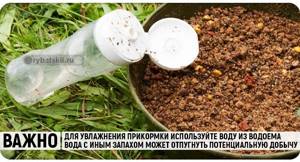
Then you need to make a batch of complementary foods, in the preparation of which ground grain or corn kernels are used. Flavoring is added to the dry pulp. Fishing stores have a large selection of special bite activators, but to attract bream you can use vanilla or anise. Then water from the reservoir is added to the bait, which will not scare off the prey, unlike tap water. Finely ground worms or bloodworms are often added to the porridge. Next, the fishing spot is fed.
When starting casting, using the assembled equipment, several throws are made to a certain place. The prepared bait is filled into the feeder, and the hook is baited with a bait or a combination of both, after which the cast itself is made. To find prey, you should recast every 5 minutes.
Winter current fishing tactics
For successful fishing, you need to pour bait into several holes and at the same time place fishing rods in two or three holes for fishing. These holes need to be located in those places where the bream is expected to be located.
The places where bream will gather must be remembered since the summer. You also need to know where in the river the current is stronger and where it is quiet. In the area where the quiet current will collect natural food, holes are drilled for catching bream.
You can make two holes, lower the fishing rods into them and wait 20 minutes. If you don’t catch fish, you need to move to another place and make two new holes. For successful fishing, you should know the habitats of bream on the bottom.
To do this, from the summer on the shore, experienced fishermen remember landmarks; if this is not possible, then you need to ask experienced fishermen; they can suggest places where bream accumulate.
For effective and successful fishing, it is worth remembering that the chosen fishing location, gear, bait and feeding must be correctly selected. And for a good catch, all gear must be used for winter fishing in the current.
Let's celebrate! In specialized stores for fishermen you can buy any fishing rods, bait and bait that will correspond to the time of year and the type of fish.
